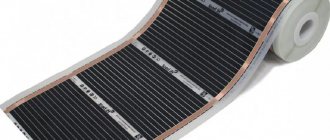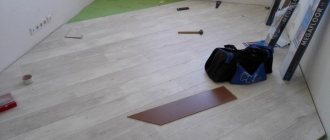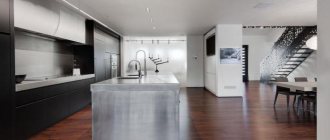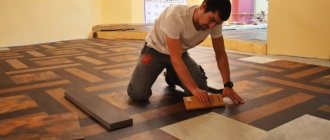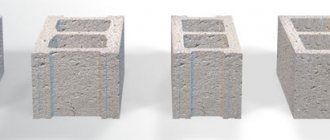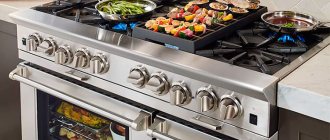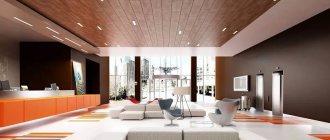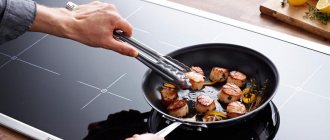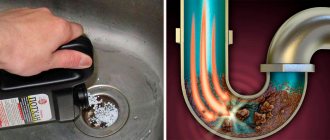In order for the laminate to serve faithfully for the entire period stated by the manufacturer, it must be laid correctly, strictly following the installation technology. For example, one of the prerequisites for laying and operating the material is the presence of a substrate layer underneath it. Nowadays, in light of the popularity of caring for one’s health and attention to the environmental situation in the apartment, coniferous underlay for laminate flooring is especially popular. How to choose the right material? Which manufacturer should you choose? How to lay the underlay? We will answer these questions in detail later in the article.
Coniferous underlay for laminate
Coniferous underlay for laminate
Careless craftsmen or newcomers to the world of construction are always trying to save money on all types of work. Naturally, the desire to spend as little money as possible also appears when laying laminate flooring. Some try to cut costs by not purchasing a substrate. But such a measure would be a gross violation of the entire material laying technology.
In the absence of a substrate that acts as a special shock absorber, the laminate will quickly become unusable - the locking connections of individual lamellas will be hopelessly damaged, as a result of which the coating will begin to move apart, cracks will appear, and debris that gets through them will cause the floor to creak. That is why you cannot neglect the use of a substrate.
Laying laminate on a substrate
Using laminate in the hallway, you can get an aesthetically attractive, strong, reliable and durable floor covering. We will tell you how to choose this material correctly in a special article.
Now on the construction market there is a huge variety of different types of laminate substrates. They differ in price, terms and characteristics of operation, quality, production technology, manufacturing materials and other factors. Recently, coniferous substrates made from natural raw materials have become popular.
Expert opinion
Afanasyev E.V.
Chief editor of the pol-exp.com project Engineer.
Coniferous underlay is a special and completely natural material, which, like other types of underlays, allows you to partially hide small defects in the subfloor and ensure the safe operation of the laminate. It is especially suitable for installation in those houses and apartments whose owners are concerned about their health, and a favorable environmental situation for them is not just empty words.
Using a coniferous substrate
On a note! Compared to other types of substrates, coniferous has a fairly high price - however, like any environmentally friendly material.
The coniferous substrate contains only natural ingredients. The base is coniferous wood and pressed pine needles. The wood is crushed, then evaporated, and then the substrate layers themselves are formed from such raw materials. The material acquired wear resistance, hydrophobicity of a certain level, heat and sound insulation properties due to the fact that it included various additional components. And the binding component in the raw material is the resin of coniferous trees, which, by the way, is also a natural substance.
Coniferous underlay for STEICO Underfloor laminate
The structure of the coniferous substrate is porous, due to which the material has heat-protective properties and can, to some extent, become a sound insulator. At the same time, the substrate breathes well, allowing fresh air into the room.
Installation of coniferous substrate
How to lay it correctly?
The technology of laying the underlay under the laminate involves not only fixing it to the surface, but also high-quality preparation of the floor. Therefore, it is advisable to perform all procedures together, as this will facilitate the process and prolong the operation of the laminate. It is advisable to lay the substrate only on a clean and level surface.
Therefore, before laying it yourself, it is advisable to vacuum the floor and remove sharp objects.
Materials and tools
Installation of the substrate begins with the acquisition of the necessary material, as well as the search for tools. For such work you will need a set of the following items:
- Substrate. Its quantity is calculated depending on the area of the room and the width of the rolled material or one sheet. It is advisable to take products with a small margin to avoid shortages due to incorrect measurements.
- Scotch. It is needed to fasten the pieces of the substrate together. This will prevent it from moving on the floor, as it should lie flat and without lumps.
- Roulette.
- Knife and square. The last element will allow you to get an even cut of the material at a right angle.
How to level the floor?
The coating under the laminate must be of the highest quality. Therefore, it is important to take care of the field itself before you begin laying the underlayment. Depending on the type of floor, its leveling may occur in different ways. The process of preparing a wooden floor can be carried out using the following approaches:
- Dry screed. This method involves the formation of a concrete layer on wood. Before this, it is important to lay down a waterproofing film to prevent the solution from getting on the wood. It is used quite rarely, as it is labor-intensive and time-consuming.
- Alignment using sheets. For such purposes, plywood, OSB or plasterboard are used. Installation of sheets is carried out directly on the old floor using screws or glue. Here it is only important to form a flat surface with minimal differences.
- Looping. This process involves removing the top layer of wood using special machines. Performed only for wooden floors of significant thickness and strength.
Preparing a wooden floor also involves a preliminary assessment of its strength. If there are rotten boards here, it is advisable to replace them with new ones.
Leveling a concrete floor can also be done in several ways:
- Grinding. This process involves removing concrete in certain areas of the room in order to level the entire plane. It is used only if the surface has minimal differences.
- Correction with cement. This approach is also used for small irregularities. A thin layer of self-leveling mixture is applied to the concrete surface. After it hardens, a flat plane is formed.
- Full screed. The algorithm involves laying beacons strictly horizontally throughout the room. Then the entire surface is filled with a thick layer of liquid concrete and carefully leveled relative to the marks.
Is it possible to lay two underlays?
Today, many people plan to use two layers of underlay to install laminate flooring. They think that this will significantly improve the thermal and sound insulation of the floor. According to the recommendations of experts, a polyethylene film can be laid as a second layer, which will protect the laminate from moisture. Installing two ordinary substrates will result in the surface becoming too soft . Over time, the locks of the laminate on such a base will simply break and the boards will begin to dangle in the air.
Therefore, it is better to use only one layer of material with high density and low thickness.
Which side should I put it on?
The substrate is made from various substances, but often its external structure does not differ. Manufacturers produce rolls in which one side is smooth and the other with small bulges or grooved. The installation of the substrate should be carried out in such a way that its smooth side faces outward.
If you are using foil products, then this layer should also be placed towards the top. This will allow it to repel heat that will try to escape through the floor.
What can you use to glue it together?
The installation of the substrate is carried out on a flat and dry base, so there is no need to fasten the material to the base. Please note that the sheets should not be fixed, so no glue is used in this case. Experts recommend gluing only the joints together using tape . This will allow you to get a smooth and solid surface that will not move while laying the laminate.
Why is coniferous underlay optimal for laminate flooring?
Laminate substrates must meet certain requirements. Otherwise they will not work correctly.
- Good leveling abilities. Due to the fact that the base of the floor will be as level as possible, the laminate will last longer than without the use of a substrate.
Technical characteristics of the substrate for laminate LATTIALEIJONA (“Lattilona”)
- Soundproofing abilities. If the substrate does not absorb sounds, then all steps and movements on the laminate will be clearly audible to household members and even neighbors.
- The material must have moisture-proofing properties. The substrate must protect the laminate from excessive moisture acting on it from the concrete surface.
- Thermal conductivity ability. If you plan to lay a heated floor under the laminate, it is important to choose a substrate that is capable of transmitting and transmitting heat. Otherwise, the effect of heated floors will be insignificant.
There are certain requirements for the substrate under the laminate
Coniferous underlayment has excellent thermal insulation properties, so sometimes you can completely abandon the underfloor heating system, since the material itself will perfectly retain heat in the room. Also, the coniferous backing allows air to pass through and at the same time absorbs moisture, so the laminate will remain dry.
On a note! Since coniferous underlayment is a porous material, it is recommended to install it in rooms with a normal level of humidity. Where it is elevated, it is recommended to carry out additional waterproofing work. If excess water gets on the pine needle substrate, mold may appear on it - after all, this is a favorable material for the development of various parasites.
Where is coniferous backing used?
Material price
The cost of a cork substrate is affected by its thickness - the thicker it is, the higher the price. The average value ranges from 70 to 750 rubles per m² for rolled material and from 400 to 1000 per m² for sheet varieties. When choosing cork as a lining for laminate and other decorative coverings, you should not save money, since the use of a low-quality lining will soon lead to damage to the floor covering.
In some cases, it is worth thinking about the advisability of purchasing expensive material. The construction market offers a wide range of cheaper linings with excellent performance properties. Buying an expensive cork when laying cheap laminate flooring is not profitable.
Table 3. Average cost per material
What types of coniferous substrates are there?
Coniferous substrates can be divided into several categories according to two parameters - the release form and the thickness of the sheet.
Table. Forms of release of pine needle substrate.
| Form | Installation features |
| Sheet | It is a material that comes in the form of small sheets. Thanks to this, installation and cutting of the substrate is very convenient. Beginners are advised to purchase material in this form, as it is easier to install. The installation of the substrate is done in strips; individual elements are sometimes glued together with special moisture-resistant tape or glue. |
| Roll | An ordinary coniferous substrate, but produced in roll format. Installation is carried out from the walls to the center of the room. This format is more difficult to work with, but it is more often chosen by professionals. |
Also, the substrate may differ in thickness. In general, this parameter can vary from 3.6 to 7 mm. Its price will depend on the thickness of the material. A substrate that is 4 mm thick copes well with floor unevenness of 1 mm, and if the material is 5 mm thick, then it masks 1-2 mm unevenness; A 7mm backing will successfully hide irregularities measuring 3mm.
Coniferous substrate Isoplaat
On a note! Some manufacturers make such a substrate to order, so purchasing a non-standard option that is convenient for each specific case is quite simple.
When choosing a substrate, the evenness of the rough base will play a decisive role. A substrate that is too thin and the floor is too curvature will not work as needed, which will lead to damage to the laminate. In general, the backing layer should be slightly smaller than the thickness of the lamellas.
Purpose
The backing for the laminate is a material that is characterized by low density. The main purpose of this substance is to smooth the surface. This is necessary when the floor level has slight differences. In this way, you can create an optimal base for the laminate, which does not tolerate strong bends.
It should be noted that the substrate is only able to level out small differences.
Therefore, preparation of the base for this material still needs to be done. If this is not done, the boards can quickly fail, even if a thick backing is used.
There are several more problems that can be solved using this product:
- Noise insulation. Some types of materials are capable of perfectly absorbing sound. Moving on laminate flooring with a backing will be pleasant, even if you walk in heels.
- Moisture insulation. The substrates are made from substances that also perfectly retain moisture. This eliminates its impact on the laminate, which simply unsticks in water. The best option would be to use polyethylene film, which is completely hygroscopic.
- Thermal insulation. Creating an optimal microclimate inside the room is one of the tasks of flooring. Substrates that do not allow cold to pass through to the laminate from the inside cope very well with this. Therefore, the board has the air temperature in the room, but at the same time it itself has poor thermal insulation parameters.
The substrate is a rolled material made from natural or artificial components. Today there are several types of similar products, among which several main products can be distinguished:
- Polyethylene foam . The substrate made from it is the most common and accessible, as it has a low cost. The substance has good moisture resistance and thermal insulation. The corrugated surface of the material is not damaged by rodents and microorganisms, which allows you to extend the service life of the floor. Today, foil-coated polyethylene, which better reflects heat, is especially popular. But this substance holds its shape very poorly and sags over time, which affects the laminate.
- Cork . Substrates of this type are made from natural substances. Cork products also do not rot and are not affected by mold. Moreover, the material retains heat very well, which makes it one of the most popular. Both roll and sheet varieties of this substrate are available on the market.
- Bitumen-cork substances. The substrates are made from cork chips and kraft paper, which contains bitumen. The cost of such products is very high, so they are used only for expensive types of flooring.
There are also combined types of substrates that combine several substances. This allows you to improve the technical characteristics of the material:
- Expanded polystyrene. The material perfectly levels the floor surface and also retains heat efficiently. Substrates made from it also do not allow sound and moisture to pass through.
- Coniferous tiles. This type of substrate is made from natural wood, which makes it completely safe for humans. The disadvantages of this material are its high cost and relatively low density, which is significantly lower than that of cork.
Advantages and disadvantages
The pine needle substrate has its advantages and disadvantages, like any other material. Only by knowing them will it be possible to determine whether the substrate is suitable for installation in each specific case. The advantages of this type of material:
- good soundproofing qualities;
- additional floor leveling;
- thermal insulation properties;
- environmental cleanliness and health safety;
- ability to keep its shape well throughout the entire period of use;
- optimal level of density;
- ease of installation.
Coniferous substrate has many advantages
Disadvantages of pine needle substrate:
- cannot be used in rooms with high humidity levels;
- an unpleasant odor that disappears only after 3-4 days from the moment the package is opened and the material is laid;
- high price;
- Coniferous substrate is a favorable environment for the development of fungus and mold.
On a note! Coniferous underlayment can only be laid on a well-dried base. Otherwise, there is a risk of mold growth.
Laying cork underlayment: what to consider
When choosing a substrate, you should pay attention to the thickness of the laminate. If it is less than 8 mm, then a lining of 2 mm is suitable; if it is larger, then the thickness of the cork should be 3 mm.
Note! Material 3–4 mm thick will help hide floor unevenness not exceeding 2 mm.
The cork underlay is laid on a flat base, so if there are significant defects and differences, preparatory measures are taken to level the floor. Comprehensive preparation of a concrete base includes the following activities:
- Removing garbage.
- Joining and sealing damage and cracks with cement mortar.
- Leveling the base by pouring screed, self-leveling mortar, laying semi-dry or dry screed.
Prices for various types of screeds and self-leveling floors
If the base is wooden, then the boards are tightened, fixed, and if necessary, the surface is scraped and sanded. Damaged boards are replaced with new ones.
There are two ways to lay the backing - adhesive and double-sided tape.
TOP 3 manufacturers of substrates based on pine needles and wood
| Photo | Name | Rating | Price | |
| #1 | Steico underfloor | ⭐ 98 / 100 | More details | |
| #2 | Leroy Merlin | ⭐ 97 / 100 | More details | |
| #3 | Isoplaat | ⭐ 96 / 100 | More details |
Steico underfloor
This spruce underlay is good where soundproofing of floors is important. Supplied in slab form. Ideal for laying under laminate on wooden floors. Often used in private homes. Steico is a leader in the production and sale of this type of substrate.
Steico underfloor (Poland)
pros
- perfectly dampens the sound of steps when moving along the base;
- has excellent thermal insulation properties;
- able to resist moisture well;
Minuses
- afraid of mold.
coniferous underlay Steico underfloor
Leroy Merlin
It acts as a capacitor for the lamellas due to the fact that it is subjected to special processing during manufacturing. This substrate is cheaper than the previous option, but its performance characteristics are quite good.
Coniferous backing from Leroy Merlin
pros
- ideal ratio of cost and quality;
- good soundproofing qualities;
Minuses
- not detected
coniferous backing Leroy Merlin
Isoplaat
The material is able to retain its shape for as long as possible. Suitable for repairing old floors.
Isoplaat (Estonia)
pros
- does not deform;
- absorbs noise well;
- can act as an insulating material;
- does not allow the laminate to cool quickly.
Minuses
- the cost is above average.
coniferous underlayment Isoplaat
Purpose of the material
To make the cork backing, crushed and compressed cork tree bark is used, so the material is environmentally friendly, natural and safe.
The substrate is produced in the form of roll or sheet material with a thickness of 2 – 4 mm. The material is durable, moisture-resistant, resistant to mold and mildew. Like any wood-based material, cork has high heat and sound insulation properties, and is easy to install and cut.
The purpose of the substrate is as follows:
- Allows you to level the surface of the base and prevent deformation of the laminate or parquet board.
- Eliminates displacement of parquet dies.
- Protects decorative material from moisture.
- Acts as a noise and heat insulating material.
The thickness of the substrate is selected depending on the base material and its quality. If the floor is uneven, then use a substrate up to 20 mm thick. For a flat concrete floor, choose a material no thicker than 2 mm.
How to lay spruce underlayment
The process of installing a spruce substrate is quite simple; anyone who carefully studies the instructions can handle it. The most important thing is to follow the basic rules, which will ensure high-quality installation.
Coniferous backing sheets
It is important to remember that the substrate must be laid on an already prepared rough base. That is, it is pre-cleaned of dirt, debris and even dust. The fact is that even the smallest foreign objects can ruin the entire work. If the floor is very uneven, it is recommended to lay it with sheets of chipboard or plywood, or even fill it with fresh screed. It is also important to first subject the floors to a waterproofing process - for example, lay polyethylene film on the base and seal all joints with tape.
Advice! The thickness of the polyethylene film must be at least 0.2 mm. Only then will the material meet the specific density requirements required for the waterproofing layer.
You will also have to worry about purchasing the tools that will be needed to lay this type of substrate. For this, you will need a tape measure and a marker or pencil for marking, as well as household scissors for cutting the material. You can also use a sharp utility knife.
We prepare everything you need
Before installation, it is recommended to bring the natural substrate into the room where the flooring will be installed. Let it sit for about 1-2 days - this time will be enough to adapt to operating conditions.
Step 1. Since the material must be laid so that the joints between the individual base plates do not coincide with the joints of the lamellas, the first elements that will be laid must be cut at a certain angle - 45 degrees. The substrate is laid at a right angle relative to the laminate. The backing sheets are marked using a tape measure and a pencil.
The first elements of the substrate are cut at an angle of 45 degrees
Step 2. Next, the material is cut. For this, a stationery knife and scissors are used. When cutting, it is convenient to use a long ruler or lamella and cut the material along it.
Cutting coniferous substrate
A lamella is used to cut the material
Step 3. Laying the first sheets (cut) is done joint to joint at an angle of 45 degrees along one of the walls. In this case, a small compensation gap is left between the substrate and the wall - about 5 mm.
Laying the first sheets of backing
Step 4. Next, whole sheets of material are also laid joint-to-joint.
Laying complete sheets of underlayment
Step 5. Then lay the laminate in the traditional way.
You will find detailed step-by-step instructions for laying laminate flooring in the article . ” We talk about the nuances, choosing a substrate and its types, the installation process and how to cut holes.
Laminate installation
On a note! To secure individual pieces of rolled backing, if this is the option used, double-sided tape may be useful. Sheet elements can also be glued together with tape or glue.
Prices for coniferous underlay for laminate flooring
coniferous underlay for laminate
Video - Laying coniferous substrate
There are many opinions regarding coniferous substrate. Some say that it is quite easy to install and has excellent performance indicators, others say that it quickly becomes unusable due to its tendency to mold. However, you will have to decide whether to use it or not on your own. One thing is indisputable - coniferous substrate can rightfully bear the title of the most environmentally friendly material belonging to this category. And if it is laid correctly, then you don’t even have to think about the appearance of mold.
Preparing the base
Lay the slabs on a concrete or wooden subfloor. If there are unevenness on the floor, you must first make a screed or level the surface using sheets of chipboard or plywood. If a concrete screed was made, it should be well dried.
Cleaning should be done thoroughly. Any small object can ruin everything.
Advice! To make sure that the concrete screed is ready, you need to put a plastic bag on it for 12 hours, carefully pressing it along the edges. If after a while there are no condensate droplets on the inner surface of the bag, then the screed is ready. If there is moisture, you still need to give it time to dry.
If the subfloor is assembled from boards, you need to make sure that it is strong; the boards should not sag. The base of any material must be thoroughly cleaned, it is best to use a powerful vacuum cleaner.
Results
The use of underlays is advisable when you use so-called floating laminate floors. This is the simplest technology that professionals like due to its speed.
An underlay is a must when installing floating laminate floors.
Previously, it was recommended to install floors of this kind with glue, which completely reduced the likelihood of squeaks, bends and other troubles. The base was well leveled under each lamella. In addition, for laying with glue, an inexpensive laminate was used, which does not have complex locks. Substrates were not necessary.
However, this work requires more time and effort, and this causes a negative reaction from both workers and firms. That's why the so-called floating method arose. Floors should not float at all, they should be stable. The final verdict regarding the installation of laminate flooring should be made by the customer after he has studied in detail the specifics of his home.
Questions and answers
Users are interested in various nuances of installing cushioning materials under laminate flooring. Let's look at the most common ones and find answers to them.
Which side should I put the backing on?
The sub-laminate base is made from different materials. For most people, it doesn't matter which side is facing up. If the surface of the material has different roughness, then the smooth side is placed up for better adhesion to the panels, and the corrugated side is placed down towards the base floor.
The canvas with foil is laid with the shiny part facing up. This will ensure that the heat tends to escape into the floor.
How to glue backing sheets?
Let's start with the fact that it is not necessary to glue the substrate together. This is done for convenience - to avoid displacement of the sheets during installation of the coating.
After laying adjacent pieces of cushioning material, they are fastened with masking or special construction tape at the joints. In this way, a solid canvas is obtained that is resistant to temporary influences during the installation of floor covering slats.
Laminate flooring is installed in a floating manner, so the underlay is not attached to the surface of the floor or covering boards in any way. It must remain mobile when the temperature and humidity of the room changes.
Do I need to put the film under the backing?
There is no clear answer to this question. A vapor barrier film under the laminate base is desirable for floors made from natural components that are susceptible to moisture accumulation. It is usually used when installing floors on wooden joists or plywood.
Also, an additional coating can play the role of additional insulation if work is carried out in cold or irregularly heated rooms, as well as in rooms with high humidity.
Where there is central heating and installation is carried out on a prepared concrete surface, it is not necessary to lay the film under the substrate.
Is it possible to lay two underlays?
Some users, in order to smooth out the flaws of poor preparation of the base floor, as well as improve thermal and noise insulation, plan to install two layers of base under the laminate. It is not right! When laying several layers of standard substrates, the base will become too soft. This will have a negative impact on the laminate locks, which will become deformed over time, and the boards will begin to sag—“playing.”
In such a situation, it is more correct to use a single-layer material of increased thickness (5-7 mm) with increased density.
How to lay the underlayment under the laminate correctly: lengthwise or crosswise?
When considering the question of how to properly lay the underlay under the laminate (lengthwise or crosswise), they start from the direction of laying the laminate boards. It is recommended to install the underlay across the panels. This reduces the risk of the joints of the substrate and laminate elements matching. Even if they coincide, the length of such connections will be insignificant. When laid lengthwise, the joints overlap at larger intervals, which causes sagging of the panels, unpleasant sounds and destruction of the locks. This shortens the service life of the coating and spoils the appearance of the material.
Is it possible to lay laminate flooring without a backing?
Despite the fact that it is theoretically possible to install laminate flooring without a base, experts categorically do not recommend doing this. On concrete or any other base, a “bare” coating will make loud noises when walking. This is uncomfortable for both the owner and neighbors.
This nuisance is due to the fact that the vast majority of manufacturers make the lower part of the laminate rigid. After installation, it knocks loudly on the subfloor when walking. Panels without a backing do not retain heat; in winter, the cold will be felt more clearly on the floor. The lack of sound insulation means that neighbors will hear not only your steps, but also your conversations.
In recent years, laminate models with a built-in backing have begun to appear. They have a special soft coating on the bottom of the panel, which essentially compensates for minor irregularities and improves the sound and heat insulation of the floor covering. This laminate can be laid immediately without a backing. However, it is worth keeping in mind that the cost of such products will be higher than conventional laminate.

